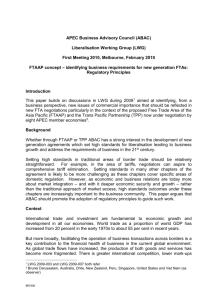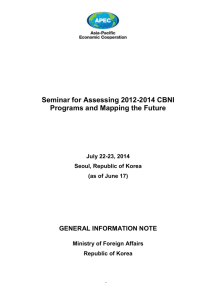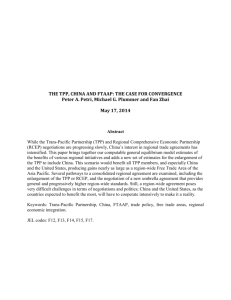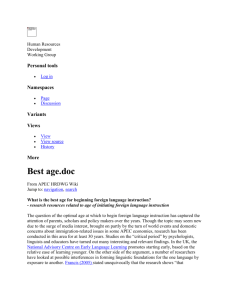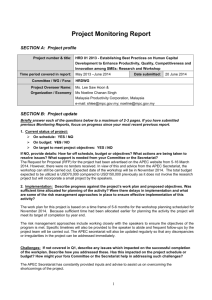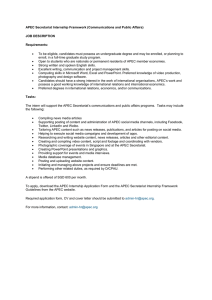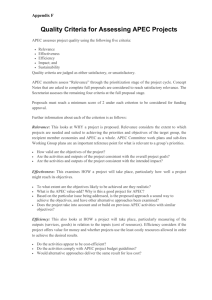Summary Report of the Seminar on the Collective of the FTAAP
advertisement
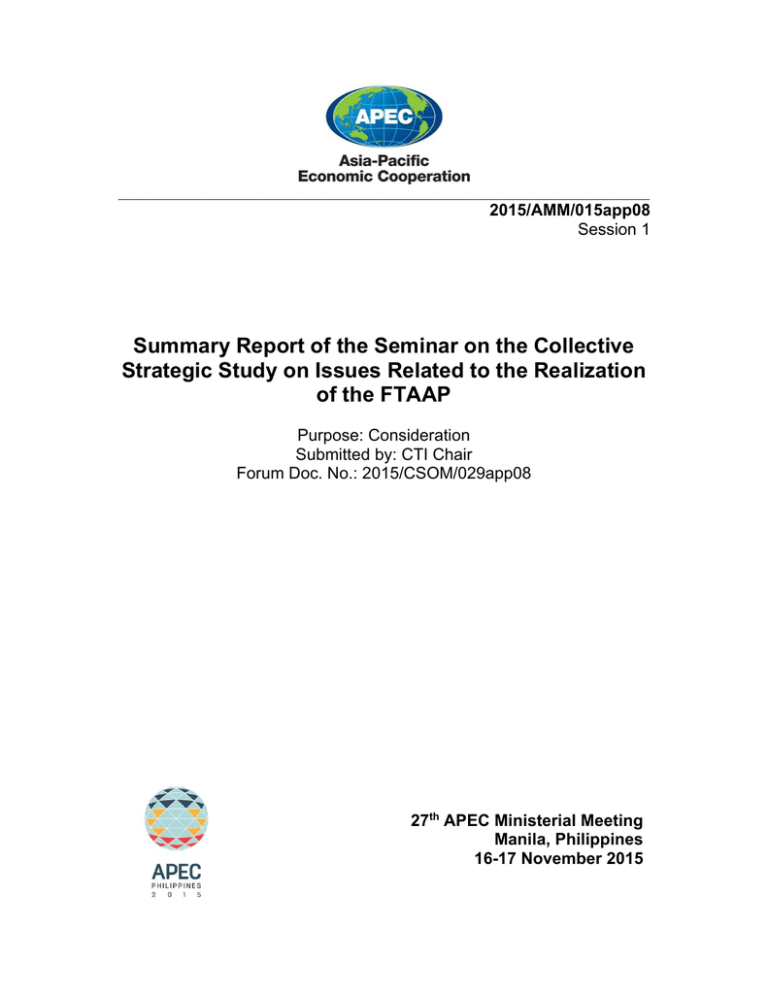
___________________________________________________________________________ 2015/AMM/015app08 Session 1 Summary Report of the Seminar on the Collective Strategic Study on Issues Related to the Realization of the FTAAP Purpose: Consideration Submitted by: CTI Chair Forum Doc. No.: 2015/CSOM/029app08 27th APEC Ministerial Meeting Manila, Philippines 16-17 November 2015 Seminar on Collective Strategic Study on Issues Related to the Realization of the FTAAP Cebu City, Philippines August 29th, 2015 Summary Report A. Introduction On August 29th, 2015, the Seminar on Collective Strategic Study on Issues Related to the Realization of the FTAAP was held in Cebu City, Philippines. The Seminar, hosted by China and co-sponsored by Peru, Philippines, Chile and the US, received over 100 participants from governments, academia and private sector of APEC economies as well as regional institutions. Participants had intensive discussions on a number of key issues related to the FTAAP, i.e. its significance & economic impact, opportunities and challenges, potential elements as well as possible pathways to the FTAAP, which provides up-to-date information and various meaningful perspectives for the Collective Strategic Study to be completed by the end of 2016. B. Background Economic integration efforts in the Asia-Pacific region have entered a critical stage, and are now facing both challenges and opportunities. The proliferation of regional RTAs/FTAs has created favorable liberalizing momentum that complements the multilateral trading system as embodied in the WTO. However, it has also resulted in a “spaghetti bowl” effect, posing complex new challenges to regional economic integration and to businesses. In this regard, in 2006, APEC economies agreed to examine the long-term prospect of a Free Trade Area of the Asia-Pacific (FTAAP). In 2010, APEC Leaders instructed APEC to take concrete steps toward realization of the FTAAP by developing and building on ongoing regional undertakings such as 1 ASEAN+3, ASEAN+6 (RCEP), and the Trans-Pacific Partnership (TPP) as possible pathways to the FTAAP. In 2014, APEC Leaders decided to kick off and advance the process in a comprehensive and systematic manner towards the eventual realization of the FTAAP and endorsed the Beijing Roadmap for APEC’s Contribution to the Realization of the FTAAP. APEC Leaders welcomed the establishment of a Committee on Trade and Investment (CTI) Friends of the Chair Group on Strengthening Regional Economic Integration (REI) and Advancing FTAAP, urged “the Friends of the Chair Group to continue its work, agreed to launch a collective strategic study on issues related to the realization of the FTAAP and instructed officials to undertake the study, consult stakeholders and report the result by the end of 2016. At SOM 1 2015, Senior Officials endorsed the Working Paper of the Study and the formation of a task force, which comprised of all 21 member economies, charged with drafting the Collective Strategic Study on Issues Related to the Realization of the FTAAP. At MRT 2015, our Trade Ministers endorsed the Terms of Reference (TOR)of the Collective Strategic Study and acknowledged the importance of this study in providing useful analysis of the opportunities and challenges ahead. In the joint statement, our Trade Ministers looked forward to the outcomes of this Seminar, which would serve as an important platform for the Task Force to review progress and discuss next steps. In addition, the TOR requested that APEC guarantee the transparency and objectiveness of the Study by consulting with ABAC, PECC, PSU and APEC Study Centers. MRT also instructed officials to report on the progress of the Collective Strategic Study by November 2015, with a view to completing the final report, along with any recommendations, by the APEC Ministerial Meeting (AMM) in 2016. In this context, China proposed to hold the Seminar at the margin of SOM3 aiming at the following specific objectives: 1) To bring together the task force, government officials, prominent REI experts from ABAC, PSU, PECC, APEC study centers, and academia, with a view to sharing information and experiences, especially on conducting the collective strategic study; 2) To exchange views on economic impact of the FTAAP, potential benefit and cost, opportunities and challenges as well as possible pathways to the FTAAP; 3) To brainstorm on possible elements to include in the Collective Strategic Study; 2 4) To develop a summary report to enrich the Progress Report to be submitted to AMM and AELM 2015. C. Discussion 1. Outcomes Altogether 16 panel speakers from governments and academia of 11 member economies as well as PSU, PECC, ABAC, APEC study centers made presentations at the Seminar. The task force members from all APEC economies, as well as other representatives from APEC governments, academia and private sector, participated in the Seminar. The Seminar was divided into four sessions: (i) Significance & Economic Impacts of the FTAAP; (ii) Opportunities & Challenges of the FTAAP; (iii) Potential Elements of the FTAAP; and (iv) Possible Pathways to Realization of the FTAAP. Each session provided opportunities for participants to share what they could take away from the Seminar as well as to suggest potential APEC-wide actions to push forward the realization of the FTAAP. Based on the survey conducted during the Seminar, the speakers, moderators and participants agreed that the project achieved its intended objectives. They considered the Seminar to be important and timely for APEC to continue to share and discuss in-depth various knowledge related to the FTAAP. They also recognized that the Seminar offers very substantial materials for the Collective Strategic Study on the FTAAP, and builds up broader consensus among APEC economies. 2. Key Issues Discussed1 Opening remarks In his opening remarks, Mr. Sun Yuanjiang, Deputy Director General, Department of International Trade and Economic Affairs, Ministry of Commerce, China, stressed the importance of the Seminar in the context that it is an important midterm activity for the Collective Strategic Study on Issues Related to the Realization of the FTAAP. He noted that since the Beijing Roadmap was endorsed by APEC Leaders in 2014, its implementation has been productive, among which the Collective Strategic Study has accomplished quite a few milestones. This has enhanced the 1. Key points of the panel speakers have been circulated and verified by the speakers respectively. 3 confidence of APEC economies in the timely conclusion of the Study and eventual realization of the FTAAP at large. He highlighted several issues that are critical to the realization of the FTAAP, including the ambition level of FTAAP, how to avoid spaghetti bowl effect, how to cope with diversities in the region, and how to narrow the gap between developed and developing economies. Mr. Sun expressed his sincere hope that the Seminar would contribute profoundly to the Study and the eventual realization of the FTAAP. Mr. Kenneth Schagrin, CTI Representative, USTR, mentioned that the Seminar was a timely event. In his speech, he pointed out two critical issues on the FTAAP. First, a possible FTAAP should be high-standard, and second, political support is essential to translate the FTAAP into reality. In terms of high-standard, he explained that the FTAAP will involve more next generation trade and investment issues rather than the simple duplication of existing FTAs. In particular, he would like to see a trade agreement with comparably high-standard and represents the unique role that the APEC region played. As for political support, he stressed the importance of support from APEC leaders and other stakeholders in achieving a relatively high-standard FTAAP. Mr. John Larkin, CTI Chair, suggested that in order to realize the FTAAP, a workable deadline was needed. By doing so, tasks can be streamlined to achieve the goal. In the meantime, he mentioned the involvement of negotiations of investment, or new generation trade and investment issues in general. Mr. Larkin also mentioned the importance of brainstorming on possible pathways to achieve high-standard FTAAP, and would like to see more collaboration in order to realize FTAAP under the deadline constraint. Panel Sessions Experts provided presentations on the following topics: 1/ During Session 1 on “Significance & Economic Impacts of the FTAAP”, there are four speakers: Mr. Alvaro de la Barra C., Studies Department, General Directorate of International Economic Affairs, Chile; Mr. Zhao Zhongxiu, Vice President, University of International Business and Economics (UIBE), China; Mr. Innwon PARK, Professor, Korea University, Republic of Korea; and Mr. Denis Hew, Director, APEC Policy Support Unit. Mr. Alvaro de la Barra C. gave a comprehensive presentation. He first highlighted significance of APEC region and mega-regional trade agreements in the region. In particular, APEC region is an area of major economic influence (in terms of economic size, trade and investment flows, and so 4 forth). Mr. Barra emphasized that proliferation of regional and mega regional trade agreements may lead to a “noodle-spaghetti bowl” on the one hand; while these attempts offer channels to achieve 21st Century Agreements. Specifically, economic growth and convergence can be achieved via mega regional integration, which includes WTO plus negotiations, new areas of agreements, global supply chains and IPR, and stronger institutions. Finally, he provided Chile’s perspective in contributing to the realization of FTAAP, that Chile has signed 24 preferential trade agreements of which 15 are with APEC members, and has realized majority of trade and investment with APEC economies. Mr. Zhao Zhongxiu started with the debate regarding cyclical phenomenon and/or structural determinants that explain recent trade slowdown. Then, he used detail tariff data and trade data constructed historical development of intra-APEC trade and APEC’ trade with the world. It is observed that despite trade slowdown worldwide, intra-APEC trade experienced more positive growth trend. Mr. Zhao explained the rationale of FTA negotiations covering more members in the context of terms-of-trade theory. In the last part, he shared his opinion concerning further studies, including model structure and data issue. And he concluded with suggestions for future studies; in particular put more effort on estimating the effects of NTBs and NTMs (i.e., behind-the-border effects), and incorporate these issues in relevant studies. Mr. Innwon Park gave quantitative estimations for a possible FTAAP. In general, he addressed three questions in the presentation. First, eight conditions were outlined to specify a desirable RTA; then, by using CGE model, he compared alternative FTA arrangements and their associated welfare effects. It is found that FTAAP would lead to largest welfare gain contrasting with TPP and RCEP. Moreover, Mr. Park showed best practices for the FTAAP and offered several policy recommendations, such as: i) Deeper integration through implementing non-discriminatory trade facilitation provisions is a desirable policy option to complement the discriminatory feature of RTAs; ii) liberalize trade in services by reducing non-tariff barriers and strengthen trade facilitation in all four areas; and iii) apply less restrictive rules of origin (ROO) and regime-wide ROO. Mr. Denis Hew kicked off his presentation by asking a critical question, i.e. “do FTAs matter for trade?” In general, FTAs impact positively and significantly on real exports. Specifically, i) FTAs are correlated positively and significantly to real exports; ii) 5 years after an FTA is enforced, average exports is higher and statistically significant vis-à-vis average exports 5 years before; and iii) Dividing the sample into those with bilateral FTA and those with regional FTA, and analyzing them separately, lead to the same conclusion. Then, Mr. Hew compared income gains under various trade 5 arrangements and using different scenarios, he reached to the conclusion that FTAAP would be most favorable (contrasting with TPP or RCEP). One step further, he reviewed the development of the concept of FTAAP within APEC Leaders’ Declarations. Finally, he addressed major issues arisen from next generation trade and investment from the perspective of APEC Policy Support Unit, in response to those issues, APEC has initiated specific action plans to various degrees. 2/ During Session 2 on “Opportunities & Challenges of the FTAAP”, there were four speakers: Mr. Datuk J. Jayasiri, Deputy Secretary General (Strategy & Monitoring), Ministry of International Trade and Industry, Malaysia; Mr. Robert Scollay, head of New Zealand’s APEC Study Centre, University of Auckland, New Zealand; Mr. Li Wentao, Associate Professor, China’s APEC Study Center, Nankai University, China; Mr. Eduardo Pedrosa, Secretary General, Pacific Economic Cooperation Council (PECC). Mr. Datuk J. Jayasiri approached the issue by stressing both opportunities and challenges for FTAAP. By assuming that i) all Asia-Pacific economies will have the opportunity to participate; and ii) TPP and RCEP to provide the building blocks, he expressed the opportunities of FTAAP in terms of to realize the vision of Bogor Goals, supply chain boost and enhance competitiveness and so on. However, challenges remained for both the process and the substance to realize the FTAAP. As for the process, Mr. Jayasiri outlined several concerns, such as whether it is extension of TPP and RCEP or fresh negotiation; what will be the criteria for participation – open or selective; transparency issue; timelines; and political involvement – Ministries / Leaders. Concerning the challenges for the substance, he suggested serious considerations given to scope, ambition, and rules, and so on. Mr. Robert Scollay started his presentation by providing the opportunity of the FTAAP, which is to fulfill the potential of the Asia-Pacific as an economically integrated region. In particular, FTAAP presents opportunities to i) achieve the Bogor Goals, intra-regionally; ii) form a fully integrated region; and iii) address the needs of 21st century trade. He stressed the challenges in three broader aspects, for example, completing TPP and RCEP as robust platforms for FTAAP. Then, he considered separately trade in goods (trade barriers and ROO), trade facilitation (SPS, TBT, Customs etc.), trade in services, investment, and intellectual property, as well as behind the border issues. Last but not least, he emphasized the role of APEC in meeting challenges to realize the FTAAP in the way of capacity-building and consensus-building. Mr. Li Wentao started his presentation by reviewing the progress in advancing FTAAP. He then 6 outlined three potential benefits and opportunities of FTAAP, namely economic benefit to world economy, balancing the parallel tracks of FTA negotiations in this area, and complying with the trend of GVC. On the other hand, remaining challenges also existed. These include political trust, economic development gap in the region, domestic benefit compensation mechanism, FTA utilization rate by business and so on. Finally, he expressed his hope to improve political consensus in order that economic benefits could be realized in the context of FTAAP. Mr. Eduardo Pedrosa approached the issue by providing his observation of the stagnation of WTO DDA, which required alternative policy arrangements. In order to meet Bogor Goals in 2010, “more work remained to be done.” On the other hand, the FTAAP is not free of challenges. Two main challenges are respectively the divergent views on the ambitions level, and political will. Nevertheless, Mr. Pedrosa expressed his positive views about the opportunities FTAAP had. He gave several recommendations regarding the realization of FTAAP: i) need for guiding principles for an FTAAP; ii) Need to reconcile high standards with the capacities and needs of diverse economies; iii) Need for innovative provisions for cooperation to help reduce development gaps; and iv) Need to connect Pacific and Asian tracks of integration to encourage overlap. 3/ During Session 3 on “Potential Elements of the FTAAP”, there were four speakers: Ms. Kejpiroon Kate Kohsuwan, Executive Director, Department of Trade Negotiations, Ministry of Commerce of Thailand; Mr. Hikari Ishido, Professor of International Economics; Director, APEC Study Center, Chiba University, Japan; Mr. Roy Chun Lee, Deputy Director, Chinese Taipei WTO Center; Mr. Ganeshan Wignaraja, Advisor, Economic Research and Regional Cooperation Department, Asian Development Bank. Ms. Kejpiroon Kate Kohsuwan started her presentation by providing the proliferation of FTAs in recent decades. She then provided experiences of FTA negotiations for both Thailand and ASEAN. Based on in-depth study of contents included in FTA negotiations, she found that emerging issues frequently influence government policies in undertaking FTAs. Moreover, trading partners might have different interests towards wide-range issues based on their differing levels of development. Nevertheless, new generation FTA normally includes new issues such as intellectual property protection, government procurement, competition, labour, and environment as well as traditional issues like goods, services and investment. And it is her view that Free trade does not necessarily mean Fair trade because FTA exposes SMEs to compete with MNCs, in which sense, she concluded by raising the question of how to balance different interests within FTAAP negotiations. 7 Mr. Hikari Ishido stressed the importance of the liberalization of trade in services to realize a highstandard FTAAP. He first highlighted the significance of physical and institutional connectivity for FTAAP. Through careful work on WTO’s GATS, Mr. Ishido re-classified GATS categories which allowed for a “bird’s-eye view” analysis of the commitment tables. By so doing, he found eight chokepoints of supply chains for APEC. Further, he advocated that APEC could formulate its own version of service trade liberalization target, under the vision to establish the FTAAP (which he termed “FTAAP as the de-facto WTO”). In the end, he concluded by emphasizing the indispensable role of service trade liberalization to FTAAP agendas. In particular, what we need as a potential element of the proposed FTAAP is a common and ambitious template for APEC-wide service trade liberalization which secures high-level and harmonized foreign equity participation. Mr. Roy Chun Lee started his presentation by providing an overview of the relationship between time required and the level of integration, and three types of integration are outlined, namely on the border liberalization, behind the border liberalization, and across the border liberalization. Then, several services sectors were given as examples to show the magnitude of behind the border restrictions by way of comparing the results of the Hoekman index vis-a-vis the OECD’s STRI index. Finally, he provided implications recognizing the shift of focus from conventional trade barriers to behind the border measures and to next generation trade issues, such as the focus should be on behind the border regulatory reforms. He suggested that the refinement of regional-wide database is critical in unveiling the priority areas for future liberalization efforts. Mr. Ganeshan Wignaraja stressed the point of business relevance when designing a developmentfriendly FTAAP. In order to achieve that goal, global supply chain perspective should be adopted where development considerations need to be taken full account. Then, Mr. Wignaraja found that business viewed the Asian “Noodle Bowl” type of FTAs as a future risk. Based on these findings, he recommended that the design of FTAAP should cover the following elements: i) Core elements: Bloc 1: Goods, services and investment; Bloc 2: Competition, public procurement and intellectual property; and Bloc 3 SMEs, cooperation and capacity building; and ii) Other key considerations, such as organization of negotiations, an FTAAP secretariat, business support for SMEs, and open accession for new members. 4/ During Session 4 on “Possible Pathways to Realization of the FTAAP”, there were four speakers: Mr. Michael Mugliston, Special Negotiator, Free Trade Agreement Division, Department of Foreign 8 Affairs and Trade, Australia; Mr. Maddaremmeng A. Panennungi, Researcher and Lecturer, Department of Economics, Faculty of Economics, University of Indonesia; Mr. Kenichi Kawasaki, Senior Fellow, National Graduate Institute for Policy Studies (GRIPS), Japan; Mr. Javier Rosas, Head of the General Office of Economic Studies of the Vice Ministry of Foreign Trade, Peru. Mr. Michael Mugliston started his presentation by providing the evolution of Australia’s participation in regional economic architecture from 2004 till 2015. It was found that the progress was remarkable. At the same time, Mr Mugliston analysed the FTAs centred on ASEAN, including the relationship between these and bilateral FTAs with individual ASEAN Member States. He also analysed the bilateral FTAs among the 6 non-ASEAN RCEP participating countries. Finally, he shared his idea about challenges and opportunities to realize the FTAAP: i) how to build on existing FTAs; ii) how to accommodate diverse national circumstances and broad interests; iii) securing a truly regional FTA; and iv) its relationship with other FTAs. Mr. Maddaremmeng A. Panennungi introduced the issue by linking the Bogor Goals and FTAAP. The FTAAP that support “open regionalism” could be one of the ways to realize the Bogor Goals; however this kind of FTA should be discussed further. Based on trade data for APEC economies in 2014, he found that export share of APEC members to all APEC economies was 72.9% on average. Then he compared world export share from APEC economies to TPP12, RCEP12 (economies not in APEC are dropped) and APEC, and found that average of export of each APEC economies to APEC was much higher than the export to TPP12 and RCEP12 (72.9% on average (APEC) vs. approximately 40.4% on average (TPP 12) and 44.5% on average (RCEP12). Moreover, by examining the existing FTAs within APEC, he found divergent attitudes among different economies, but there is a message that most APEC economies are eager to improve their economic integration in APEC through FTAs, and could drive APEC-wide FTA under FTAAP. To realize the FTAAP, several pathways were ranked according to a survey of opinion leaders, and TPP and RCEP are included. He concluded by providing his thoughts about possible pathways to the FTAAP and urged to use the year 2020 as the wake up call to realize the Bogor Goals through the FTAAP. Mr. Kenichi Kawasaki approached the issue by providing overview of economic analysis concerning TPP and RCEP toward FTAAP. He found that TPP and RCEP complemented each other rather than competing toward the establishment of FTAAP. In fact, larger economic benefits are expected from NTMs reductions in addition to tariff removals. Mr. Kawasaki observed that tariff reductions in East Asia vary significantly in terms of the initial and final levels of tariff rates as well 9 as the degrees of tariff cuts. Finally, he suggested that East Asian economies would remain benefit largely from future trade liberalization and provided global EPAs research consortium for estimating respectively tariff concessions and NTMs. Mr. Javier Rosas centered his talk from the perspective of the Pacific Alliance. He started by introducing main objectives of the Pacific Alliance, including integration among members and global outreach prospects. Then, Mr. Rosas reported economic indicators for Pacific Alliance members, and he found that in terms of trade the Pacific Alliance had a dependence ratio of no less than 76% with APEC. Moreover, he gave detail introduction of Pacific Alliance negotiations, based on which he observed that such negotiation was built upon existing trade agreements. It served as an alternative pathway to the realization of FTAAP. At the end of the Seminar, Mr. John Larkin and Mr. Sun Yuanjiang gave conclusion remarks and announced the closing of the Seminar. D. Conclusions and Implications Main messages touched upon by the Seminar are as follows: i) Intra-APEC trade has been found to be significant. If the FTAAP is achieved, it could bring profound and tangible economic benefits to the APEC region, addressing the spaghetti bowl effect of regional FTAs, boosting more economic growth and increasing welfare for businesses and people in the region. It is estimate that if the FTAAP was in place by 2025, it would bring a 4%-5% increase of GDP in the whole region from now and 2% of world total GDP, thus the potential benefit is larger than that of either TPP or RCEP. The FTAAP would also create positive externalities on the rest of the world. ii) The major challenges to the realization of the FTAAP include the balancing of several issues, such as the development gap between developed economies and developing economies, interests of businesses and consumers, as well as strong economic growth and domestic reform, etc. iii) Several guiding principles were suggested towards the realization of the FTAAP, such as aligning with Bogor Goals, consistent with WTO, building on existing regional FTAs, strengthening ECOTECH and complying with GVCs. For example, to address the development gap among 10 members in the FTAAP process, members can borrow experiences as a reference from RCEP which has been actively exploring ways to enhance economic and technical cooperation. iv) The possible pathways to the FTAAP could be more diversified than TPP and RCEP, with other regional integration undertakings making meaningful contributions as well. It is possible that the FTAAP be pursued in the “early harvest” approach. v) Regarding the general picture of the FTAAP, it should be open in nature, attempting to achieve comparatively high-standard and comprehensiveness. In terms of timing, as long as there were political wills, economic needs, and common vision, negotiations on the FTAAP could be launched. 11
